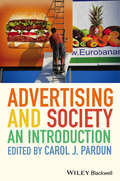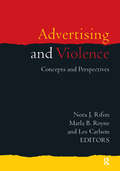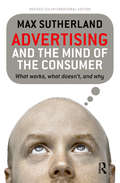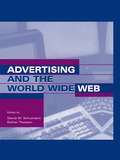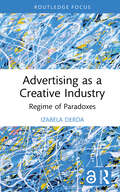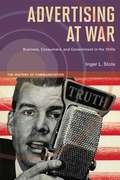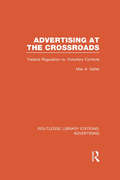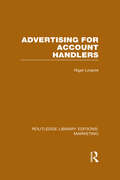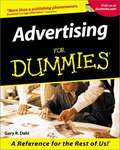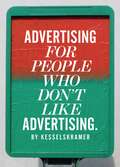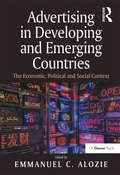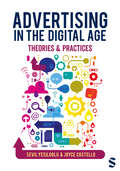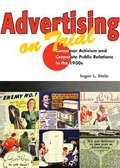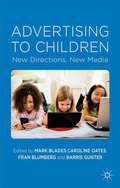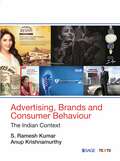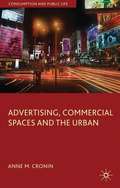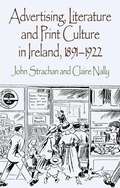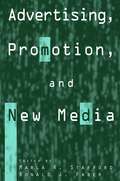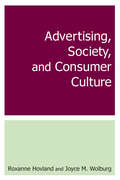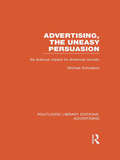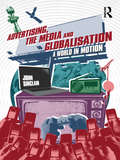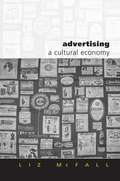- Table View
- List View
Advertising and Society: An Introduction
by Carol J. PardunNow revised and updated to reflect the impact of emerging technologies, this new edition of Advertising and Society: Controversies and Consequences examines the evolution of advertising and its influence on society. Expanded with five new chapters covering the impact of emerging technologies, including the evolution of Direct to Consumer (DTC) pharmaceutical advertising; product placement in various media; and the growing intrusiveness of Internet marketing Explores a broad range of topics including alcohol, tobacco, and sex in advertising; the pros and cons of negative political adverts; advergrames; and the use of stereotypes Examines the impact of advertising through its distinctive ‘point/counterpoint’ format –designed to spark discussion and help students understand the complexities of the issues being presented Lends substantial clarity to the subject, uniquely balancing criticism and practice within one text Includes chapter-level overviews and summaries of the topic history and key issues, along with student-friendly features such as ideas for papers and questions for discussion
Advertising and Violence: Concepts and Perspectives
by Nora J. Rifon Marla B Royne Les CarlsonAdvertising and Violence identifies and analyzes the important issues related to violence in advertising and its overall effects on society. The book is based on a widely cited special issue of the Journal of Advertising and includes eight new chapters that expand the book's coverage.The objective of the book is to compile a compendium of current thinking, perspectives, theoretical viewpoints, and research relevant to the violence and advertising interface. The chapter authors, all notable experts in the field, take a multidisciplinary approach that incorporates perspectives from disciplines other than marketing in order to provide a broad-based view of how advertising and violence coalesce and the policy implications of this juxtaposition.
Advertising and the Mind of the Consumer: What works, what doesn't and why
by Max SutherlandBy the time we die, we will have spent an estimated one and a half years just watching TV commercials. Advertising is an established and ever-present force and yet, as we move into the new century, just how it works continues to be something of a mystery.In this 3rd international edition of Advertising and the Mind of the Consumer, renowned market researcher and psychologist Max Sutherland reveals the secrets of successful campaigns over a wide range of media, including the web and new media. Using many well-known international ads as examples, this book takes us into the mind of the consumer to explain how advertising messages work - or misfire - and why.Advertising and the Mind of the Consumer is not just a 'how to' book of tricks for advertisers, it is a book for everyone who wants to know how advertising works and why it influences us-for people in business with products and services to sell, for advertising agents, marketers, as well as for students of advertising and consumer behaviour.'Essential reading for all practitioners and everyone interested in how advertising works .' - John Zeigler, DDB Worldwide.'Finally, a book that evades the 'magic' of advertising and pins down the psychological factors that make an ad succesful or not. It will change the way you advertise and see ads.' - Ignacio Oreamuno, President, ihaveanidea.org'. reveals the secrets of effective advertising gleamed from years of sophisticated advertising research. It should be on every manager's bookshelf.' - Lawrence Ang, Senior Lecturer in Management, Macquarie Graduate School of Management'Breakthrough thinking. I have been consulting in the advertising business and have taught graduate level advertising courses for over 20 years. I have never found a book that brought so much insight to the advertising issues associated with effective selling.' - Professor Larry Chiagouris, Pace University'Puts the psyche of advertising on the analyst's couch to reveal the sometimes surprising mind of commercial persuasion.' - Jim Spaeth, Former President, Advertising Research Foundation
Advertising and the World Wide Web
by Esther Thorson David W. SchumannThe chapters provide a wide-ranging view of issues addressing how advertisers can proceed on the Internet and World Wide Web. An initial chapter traces the development of Web advertising from its very beginnings as it was represented and discussed in the pages of Advertising Age. Although there is a noticeable trend to define Web advertising by comparing it to traditional media, it is clear that Web advertising just won't fit the old mold. Keith Reinhard of DDB Needham actually articulates this linkage between the old and new in his invited chapter. What the reader will encounter in Advertising and the World Wide Web is a solid conception of how Web advertising is different from anything that has come before. There are numerous discussions on consumer and advertiser interactivity, the role of Web advertising within larger campaigns, audience segmentation, and alternative Web-based promotion formats. The five sections cover definition and theory, structure, specific applications, legal issues, and the voice of the practitioner. Although there remain a few nay-sayers concerning the future of Web advertising, the reader will be able to see just how incredibly high-impact this new medium has become and the vast potential that it holds for future promotional endeavors.
Advertising as a Creative Industry: Regime of Paradoxes (Routledge Research in the Creative and Cultural Industries)
by Izabela DerdaAt the crossroads of culture and commerce, the advertising industry is a regime of paradoxes. This book examines the place of advertising in today’s creative industries, exploring the major challenges advertisers confront as they engage with other creative sectors. Izabela Derda, author, media scholar, and industry expert, offers insights into how the industry keeps deconstructing its own creative processes and collaborative models as it attempts to stay relevant. Through extensive case studies and interviews with industry professionals and thought leaders, this book examines the sector’s struggle to adapt to new business models and to monetize creativity in today’s media landscape, from re-engaging audiences through media more typical of arts and entertainment to managing intricate cross-sectoral creative collaborations. From redesigning workplaces to satisfy the expectations of the youngest generations of creatives to reconsidering the paradigm of conventional creative teams, the advertising sector has swiftly adjusted to the seismic changes in today’s media landscape. The book will be of interest to scholars and students of creative media, advertising, and media studies, as well as those interested in understanding the changing complexities and latest innovations of the creative industries. Advertising professionals, artists, and policymakers will find relevant insights and possible solutions for the major challenges facing the advertising industry today.
Advertising at War: Business, Consumers, and Government in the 1940s
by Inger L StoleAdvertising at War challenges the notion that advertising disappeared as a political issue in the United States in 1938 with the passage of the Wheeler-Lea Amendment to the Federal Trade Commission Act, the result of more than a decade of campaigning to regulate the advertising industry. Inger L. Stole suggests that the war experience, even more than the legislative battles of the 1930s, defined the role of advertising in U.S. postwar political economy and the nation's cultural firmament. She argues that Washington and Madison Avenue were soon working in tandem with the creation of the Advertising Council in 1942, a joint effort established by the Office of War Information, the Association of National Advertisers, and the American Association of Advertising Agencies. Using archival sources, newspapers accounts, and trade publications, Stole demonstrates that the war elevated and magnified the seeming contradictions of advertising and allowed critics of these practices one final opportunity to corral and regulate the institution of advertising. Exploring how New Dealers and consumer advocates such as the Consumers Union battled the advertising industry, Advertising at War traces the debate over two basic policy questions: whether advertising should continue to be a tax-deductible business expense during the war, and whether the government should require effective standards and labeling for consumer products, which would render most advertising irrelevant. Ultimately the postwar climate of political intolerance and reverence for free enterprise quashed critical investigations into the advertising industry. While advertising could be criticized or lampooned, the institution itself became inviolable.
Advertising at the Crossroads: Federal Regulation Vs. Voluntary Controls (Routledge Library Editions: Advertising)
by Max A. GellerAdvertising today is not only under sterner scrutiny by the various federal regulatory and judicial bodies but is also facing an ominous storm of public criticism because of certain abuses. One of the big questions troubling advertisers, agencies and media is whether advertising will be subject to increasingly stringent governmental controls or whether it will forestall such action by mature self-regulation. In Advertising at the Crossroads the author has attempted to face the issue squarely and realistically, and to point out several constructive measures that advertising must initiate in its self-interest. First published in 1952.
Advertising for Account Holders (Routledge Library Editions: Marketing)
by Nigel LinacreThe account handler is a key person within an advertising agency, liaising between the client on the outside and the planning, creative and media function within. This book presents essential checklists for each aspect of the planner’s role: presentations made to clients, briefing creative and media teams, and helping to get the best out of both client and agency.
Advertising for Dummies
by Gary DahlFor small businesses, effective advertising can mean the difference between fortune and failure. But if you're going to throw your money into advertising willy-nilly you might as well just throw it away. And if your business can't afford a big advertising firm you may have to write your own advertising copy. But could you? Don't worry, because with Advertising For Dummies, you will! If you need help figuring out which advertising media offers you the most exposure or determining how much you can realistically spend on your advertising budget, then look no further. If you want shortcuts, insights, techniques, and money-saving facts that will get you the most bang for your advertising buck, then this is the book for you. It's a guide to advertising for the rest of us - people for whom an advertising budget represents an important percentage of gross income and, therefore, must be spent very wisely. Inside you'll find out how to: Devise a realistic advertising budget Define and position your message Create TV, radio, billboard, and Internet advertising Use "ad-speak" effectively This helpful guide covers every media, from Internet advertising to TV and radio to billboards or newspapers. You'll master the fundamentals of advertising, learn to generate fresh ideas, and write great ads. You'll write great press releases and discover the secret to saving money through co-op ads. And there's more: When and how to hire an ad agency Why people choose one product over another Creating brochures and direct mail pieces Designing an effective, inviting Web site Sticking to a budget The difference between PR and publicity Ten secrets to writing memorable ads Sometimes if you want something done right you have to do it yourself. Advertising For Dummies presents the tips and tricks that advertising professionals use every day to get their message across. Now, you can use those same strategies and tactics to get the word out about your small business - and watch the money roll in!
Advertising for People Who Don't Like Advertising
by KesselsKramerThis is a book by a company that dislikes advertising as much as anyone. Nevertheless, it makes adverts. It has worked with global brands to produce fashion collections and promoted a town with a mass wedding. It creates advertising with more human, truthful communications. The company's name is KesselsKramer.This book describes how to make something you like out of something you don't. As well as drawing on its own experiences, KesselsKramer listens and learns from those who doubt the advertising industry. Stefan Sagmeister explains how quitting work makes you better at working; Hans Aarsman discusses authenticity in image-making; and Alex Bogusky looks at ways to help capitalism grow up.Advertising for People Who Don't Like Advertising is partly a creative handbook and partly an attempt to make the world a very slightly better place. It's intended for anyone who has ever hated a web banner or zapped an ad break.
Advertising for People Who Don't Like Advertising
by KesselsKramer KesselsKramerThis is a book by a company that dislikes advertising as much as anyone. Nevertheless, it makes adverts. It has worked with global brands to produce fashion collections and promoted a town with a mass wedding. It creates advertising with more human, truthful communications. The company's name is KesselsKramer.This book describes how to make something you like out of something you don't. As well as drawing on its own experiences, KesselsKramer listens and learns from those who doubt the advertising industry. Stefan Sagmeister explains how quitting work makes you better at working; Hans Aarsman discusses authenticity in image-making; and Alex Bogusky looks at ways to help capitalism grow up.Advertising for People Who Don't Like Advertising is partly a creative handbook and partly an attempt to make the world a very slightly better place. It's intended for anyone who has ever hated a web banner or zapped an ad break.
Advertising in Developing and Emerging Countries: The Economic, Political and Social Context
by Emmanuel C. AlozieThis indispensable study offers an in-depth analysis of advertising in developing and emerging economies as they join the global market and seek to improve the socio-economic condition of their citizens. Advertising in Developing and Emerging Countries illustrates the challenges and opportunities for advertising in these countries, and explores their critical relationship with developed economies with a multifaceted analysis of the role of advertising in an interdependent global economy. The contributors, academic and professional, with world wide experiences, examine the unique political, cultural and religious systems that affect advertising in a country, in both Western and non-Western contexts, and chart the consequences of its development from democratization to privatization to cultural hegemony. Emmanuel C. Alozie has put together an essential and unique book for scholars and students of public relations, advertising, marketing, media and international studies, as well as practitioners, those teaching and undertaking professional courses, and researchers in this critical field.
Advertising in the Aging Society: Understanding Representations, Practitioners, And Consumers In Japan
by Florian Kohlbacher Michael PrielerPopulation aging is a powerful megatrend affecting many countries around the world. This demographic shift has vast effects on societies, economies and businesses, and thus also for the advertising industry. Advertising in the Aging Society presents insights from a large-scale content analysis as well as questionnaire surveys among advertising practitioners and consumers in Japan. As the most aged society in the world, Japan lends itself as particularly suitable to study the implications of population aging. This book shows that older people, and especially older women, are highly underrepresented in advertising and are generally portrayed in stereotypical, albeit not necessarily unfavorable ways. This is despite the fact that advertising practitioners have a generally positive view towards using older models, even though only for an older target audience. Finally the book explore how both younger and older consumers perceive the representation of older people in advertising as stereotypical and partly negative, and are willing to boycott companies portraying older people negatively.
Advertising in the Digital Age: Theories and Practices
by Joyce Costello Sevil YesilogluAdvertising is everywhere. Whether you realise it or not, it′s there when you watch your favourite Netflix show, when you scroll through Instagram, and when you search on Google. What′s more, advertisers are becoming more savvy than ever, using new technologies to target adverts to you specifically. So what are we to make of all this? This book will equip you with a thorough understanding of today′s media environment and how ′online′ advertising differs from traditional ′offline′ models. In an age of influencers, big data, AI and social media, the world of advertising looks very different from how it did a generation ago. You will learn not only about various types of advertising, but also about its impact on viewers, from our buying habits to possible harm. Tying theory and concepts to practice, this volume is the ideal complement to courses in advertising, digital media and communication, and will enable you to form a clear picture of the reality of working across promotional media industries.
Advertising in the Digital Age: Theories and Practices
by Joyce Costello Sevil YesilogluAdvertising is everywhere. Whether you realise it or not, it′s there when you watch your favourite Netflix show, when you scroll through Instagram, and when you search on Google. What′s more, advertisers are becoming more savvy than ever, using new technologies to target adverts to you specifically. So what are we to make of all this? This book will equip you with a thorough understanding of today′s media environment and how ′online′ advertising differs from traditional ′offline′ models. In an age of influencers, big data, AI and social media, the world of advertising looks very different from how it did a generation ago. You will learn not only about various types of advertising, but also about its impact on viewers, from our buying habits to possible harm. Tying theory and concepts to practice, this volume is the ideal complement to courses in advertising, digital media and communication, and will enable you to form a clear picture of the reality of working across promotional media industries.
Advertising on Trial: Consumer Activism and Corporate Public Relations in the 1930s
by Inger L. StoleIt hasn't occurred to even the harshest critics of advertising since the 1930s to regulate advertising as extensively as its earliest opponents almost succeeded in doing. Met with fierce political opposition from organized consumer movements when it emerged, modern advertising was viewed as propaganda that undermined the ability of consumers to live in a healthy civic environment. In Advertising on Trial, Inger L. Stole examines how these consumer activists sought to limit the influence of corporate powers by rallying popular support to moderate and transform advertising. She weaves their story together through the extensive use of primary sources, including archival research done with consumer and trade group records, as well as trade journals and a thorough engagement with the existing literature. Stole's account of this contentious struggle also demonstrates how public relations developed as a way to justify laissez-faire corporate advertising in light of a growing consumer rights movement, and how the failure to rein in advertising was significant not just for that period but for ours as well.
Advertising to Children: New Directions, New Media
by Barrie Gunter Caroline Oates Mark Blades Fran BlumbergThis important source for students, researchers, advertisers and parents reviews the debates and presents new research about advertising to children. Chapters cover food and alcohol advertising, the effects of product placement and new media advertising, and the role of parents and teachers in helping children to learn more about advertising.
Advertising, Brands and Consumer Behaviour: The Indian Context
by S Ramesh Kumar Anup KrishnamurthyThe book Advertising, Brands and Consumer Behaviour through the exploration of 79 well-known Indian brands, explains how consumer behaviour is applied in conjunction with advertising management and brands. The Indian examples from varied product categories will enable students to identify with the conceptual linkages that occur across branding, advertising and consumer behaviour. The USP of the book is that it adds value and practical insights to the fundamentals dealt with in the various textbooks on the subject. Besides being a reference book for students of post graduate programmes in management, the book will be useful for professionals in the domain of marketing. The exercises presented in the book will enable students to readily connect with the Indian environment. Further, there are references to research readings that will help readers to probe deeper into the linkages across the three subjects. Key Features: Focuses on building conceptual perspectives that trigger critical thinking in a given context Provides real-life examples of brands (creating theory - practice linkages) Covers several well-known Indian brands across product categories Includes online resources explaining the use of the book for instructors of consumer behaviour courses and related subjects.
Advertising, Commercial Spaces and the Urban
by Anne M. CroninProviding a detailed account of contemporary outdoor advertising and its relationship with urban space, this book examines what the outdoor advertising industry tells us about the commercial production of urban space, what industry practices reveal about contemporary capitalism, and how ads and billboard structures interface with spaces of the city
Advertising, Literature and Print Culture in Ireland, 1891-1922
by John Strachan Claire NallyThis is the first study of the cultural meanings of advertising in the Irish Revival period. John Strachan and Claire Nally shed new light on advanced nationalism in Ireland before and immediately after the Easter Rising of 1916, while also addressing how the wider politics of Ireland, from the Irish Parliamentary Party to anti-Home Rule unionism, resonated through contemporary advertising copy. The book examines the manner in which some of the key authors of the Revival, notably Oscar Wilde and W. B. Yeats, reacted to advertising and to the consumer culture around them. Illustrated with over 60 fascinating contemporary advertising images, this book addresses a diverse and intriguing range of Irish advertising: the pages of An Claidheamh Soluis under Patrick Pearse's editorship, the selling of the Ulster Volunteer Force, the advertising columns of The Lady of the House, the marketing of the sports of the Gaelic Athletic Association, the use of Irish Party politicians in First World War recruitment campaigns, the commemorative paraphernalia surrounding the centenary of the 1798 United Irishmen uprising, and the relationship of Murphy's stout with the British military, Sinn F#65533;in and the Irish Free State.
Advertising, Promotion, and New Media
by Marla R. Stafford Ronald J. FaberToday, new media enter our lives faster than ever before. This volume provides a complete, state-of-the-art overview of the newest media technologies and how they can be used in marketing communications - essential information for any organization that wants to maintain an effective advertising program, as well as for experts and students in the fields of advertising and mass communications. Advertising, Promotion, and New Media offers crucial insights on the use of cutting-edge techniques including 3-D advertising, mobile advertising, advergames, interactivity, and netvertising images, as well as more familiar Internet advertising formats such as banner ads and pop-ups. It also discusses such important topics as how to select online affiliates, and how to assess the effectiveness of new media advertising and compare it with traditional formats. Throughout the book, the chapter authors offer up-to-date information and thought provoking ideas on emerging technology and how it can be used effectively for advertising and promotion in the future.
Advertising, Society, and Consumer Culture
by Roxanne Hovland Joyce M. WolburgDesigned as a core textbook for courses in Advertising and Society, "Advertising, Society, and Consumer Culture" develops an integrated perspective that gives students a framework for understanding past, present, and future issues in advertising communications. Chapter contents cover the entire range of social, political, cultural, regulatory, and economic issues that surround advertising and its role in modern society. The many social issues addressed include advertising and gender stereotyping, advertising to vulnerable audiences, and the distribution of wealth in consumer society. "Advertising, Society, and Consumer Culture" intertwines the development of the consumer culture with its coverage of the historical, political, regulatory, and ethical issues of advertising. It includes clear, comprehensive tables that chronicle historical developments and key legal cases. The text is readable for undergraduates but provides enough depth to serve as a graduate-level text. Including extensive notes and a bibliography, it can be adopted independently, or alongside its companion volume, "Readings in Advertising, Society, and Consumer Culture".
Advertising, The Uneasy Persuasion: Its Dubious Impact on American Society (Routledge Library Editions: Advertising)
by Michael SchudsonWhat does advertising do? Is it the faith of a secular society? If so, why does it inspire so little devotion? Advertising, the Uneasy Persuasion is a clear-eyed account of advertising as both business and social institution. Instead of fuelling the moral indignation surrounding the industry, or feeding fantasies of powerful manipulators, Michael Schudson presents a clear assessment of advertising in its wider sociological and historical framework, persuasively concluding that advertising is not nearly as important, effective, or scientifically founded as either its advocates or its critics imagine. ‘Dispassionate, open-minded and balanced ... he conveys better than any other recent author a sense of advertising as its practitioners understand it.’ Stephen Fox, New York Times Book Review First published in 1984.
Advertising, the Media and Globalisation: A World in Motion
by John SinclairThis book offers a critical, empirically-grounded and contemporary account of how advertisers and agencies are dealing with a volatile mediascape throughout the world, taking a region-by-region approach. It provides a clear, systematic, and synoptic analysis of the dynamic relationship between media, advertisers, and agencies in the age of globalization, and in an era of transition from ‘mass’ to ‘social’ media. Advertising attracts much public criticism for the commercialization of culture and its apparent impact on social and personal life. This book outlines and assesses the issues involved, with regard to how they are manifested in different national, regional and global contexts. Topics covered include: advertising as an object of study global trends in the advertising industry advertising and the media in motion current issues in advertising, media and society advertising, globalization and world regions. While maintaining a contemporary focus, the book explains developments over recent decades as background to the globalisation of what it calls the manufacturing-marketing-media complex.
Advertising: A Cultural Economy (Culture, Representation and Identity series)
by Liz McfallAdvertising is often used to illustrate popular and academic debates about cultural and economic life. This book reviews cultural and sociological approaches to advertising and, using historical evidence, demonstrates that a rethink of the analysis of advertising is long overdue. Liz McFall surveys dominant and problematic tendencies within the current discourse. This book offers a thorough review of the literature and also introduces fresh empirical evidence. Advertising: A Cultural Economy uses a historical study of advertising to regain a sense of how it has been patterned, not by the `epoch', but by the interaction of institutional, organisational and technological forces.
